 Check The Oil! - Letters From Europe
Check The Oil! - Letters From Europe
Check The Oil! magazine has two regular columns that are directly related to the topic of this Website. Letter from Europe looks at the relatively undeveloped Petroliana collecting scene in Europe and also at the history of European Petrol Companies. Dave Leach's regular map column covers Oil Company Road Maps from the USA and also internationally, including Europe.
Letters from Europe
|
Fall 2016: Diesel
Noting that diesel has been in the news, with the VW defeat devices scandal, the Letter from Europe looked at how it has been marketed in Europe, starting in the 1930s with German diesel (and Shell/BP's Light Diesoleum), through French gasoil. Several globes and enamel signs were shown, including a Shell-BP T.V.O. (Tractor Vaporising Oil, or red diesel).
|
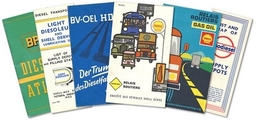
|
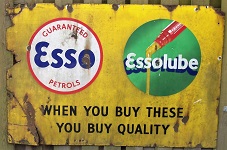
|
Early 2016 (34-03): English Motor Museums
Many English motor museums have some petroliana on show. One of the best its the Lakeland Motor Museum in Backbarrow, which has an extensive selection of globes, signs, pumps and other memorabilia on display, including rare examples from Arnoco, Pratts and ROP. The Esso/Essolube sign shown here is displayed at the museum entrance. Across the country, there's the North Yorkshire Motor Museum which tends to have more of a changing display, with a few permanent items from brands such as Shell and Golden.
|
|
Late 2015 (34-02): USA Road Trip
In Autumn 2015 I drove from San Francisco to Indianapolis. This article looks at some of the interesting sights on the way, starting with a 1920s service station building in San Francisco, and ended with a 1930s Pure cottage in Indianapolis. Between them, I saw the famed 2 Stiffs Serving Gas in Lovelock, Little America, the Sinclair Museum in Sinclair, the I-80 Truck Museum in Walcott and many abandoned gas station signs such as one for Major Gas in Wyoming.
|
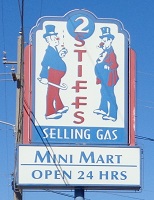
|
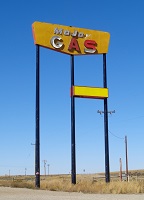
|
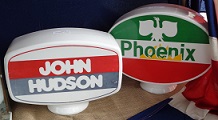
|
Mid-2015 (34-01): Beaulieu Autojumble 2015
The 2015 review showed a number of interesting old enamel Shell signs, as well as a number of items in pairs: National Benzole kerb signs, East Anglian globes (John Hudson and Phoenix, shown here), 1930s pumps, Esso bookmarks and Redex collectables.
|
|
Spring 2015 (33-04): On the Road Again
This showed a selection of interesting stations seen globally over the past couple of years, including Pure Cottage Stations in Iowa and Wisconsin (right), a Phillips 66 cottage station in Iowa (far right), a preserved DX station in Wisconsin, a 1950s moderne station in Helsinki, Shell signs in another Helsinki station, a hard to identify station in China and the remains of a Butler location in Oxfordshire.
|
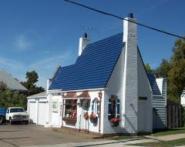
|
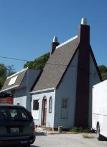
|
|
Fall 2014: Beaulieu Autojumble 2014
This year's review of the autumn Beaulieu Autojumble focused on oil cans, including some 5 gallon containers from Notwen, Staminol and Liberty, as well as French 2 litre cans from UFP, Oyo and a Huile Ricinée (castor oil based lubricant) from Terrot. Other containers were shown from Trading, Citex, Motul, Huile Renault and STP, as well as bottles from Staminol and Regent.
|
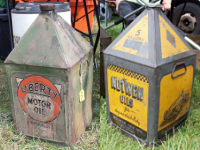
|
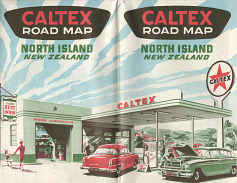
|
Summer 2014: Caltex
Following on from the Regent/Texaco theme in recent issues, this turned to Caltex, the joint venture established in the late 1930s between Standard Oil Co. of California (Chevron) and Texaco. Introduced as a brand into Europe in 1947 where it was divided up between its shareholders just 21 years later, the brand continues to be used in Asia, Australasia and South and East Africa. This article featured classic Caltex station designs, mainly taken from a global selection of road maps, including the 1954 map of New Zealand's North Island shown here.
|
|
Spring 2014: Financial Troubles in Fère-Champenoise
Henri Lambert operated a small Citroen dealership and filling station in the small town of Fère-Champenoise, about 80 miles East of Paris, between the 1930s and 1950s. Although it was apparently prosperous in the early years, after the War it ran into difficulties in paying its suppliers, which included SA de Pétroles Jupiter (Shell), Chrysoleum, Labo and Aero. It also included evidence of better relations with some other suppliers, such as Graphoïl and information about the SATAM pumps that he used to dispense petrol and diesel.
|
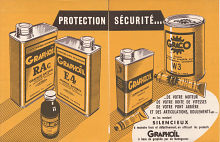
|
|
Winter 2013/4: Beaulieu Autojumble 2013
The annual review of the state of the European petroliana collectors' market at the autumn Beaulieu Autojumble included a selection of rare European cans from companies such as Zitol, Pennol and Standoleine (Hauger-Fambon), as well as enamel signs for Power, Shell from the sealed pump, Antar and Mobilgas, a Pratts High Test Plan of the Roads to Goodwood, and an ALTY thermometer.
|
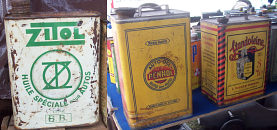
|
|
Fall 2013: Fina in Britain
Petrofina entered the UK by acquiring Cities Services' Citex operation shortly before World War II, but only introduced the Fina brand when the Pool was dissolved in 1952. The letter showed a number of 1950s Fina service stations taken from publicity materials (including a road atlas), including the futuristic design used at Rondelle Service Station in Birmingham.
|
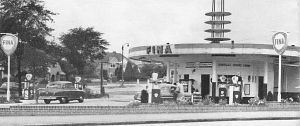
|
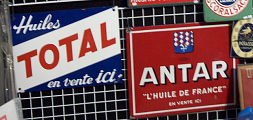
|
June/July 2013: Retromobile 2013
Retromobile is France's largest show dedicated to old cars and takes place each February in the Paris Parc des Expositions. Although there was possibly slightly les petroliana at the 2013 event than in some recent years, a selection of signs, posters, pumps and cans was shown. In addition there was an example of an illustration from the Galerie des Artistes produced by Thierry DuBois for his new book on Route Nationale 7.
|
|
Spring 2013: The End of the Pool
This Letter from Europe marked 60 years since the World War II pooling arrangements ended for the sale of petrol in Britain. At the start of the war, to protect the limited supplies of fuel, all brands were replaced with a single low octane grade called simply "Pool". The pooling arrangements continued long after the War had ended and it was only on February 1, 1953 that, as one company put it, "the thrill of branded spirit returned". The article featured several adverts dating from just before the return of branded petrol, including the National Benzole one taken from the Autocar of January 30, 1953 (right).
|
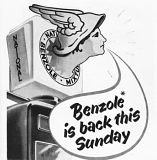
|
|
December 2012: Letter from Asia
The Letter from Europe moved East to look at Japan, including petroliana on display in the Shell Cafe Museum and Toyota History Museum in Odaiba, Tokyo, pumpless service stations with overhead fuel dispensers, identification of pole signs written solely in kana and a couple of service stations with Mount Fuji behind, including the Eneos site in Hakone shown here.
|
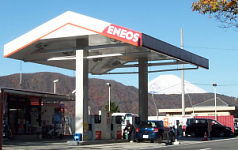
|
 October 2012: Beaulieu Autojumble 2012
October 2012: Beaulieu Autojumble 2012
This year's Beaulieu Autojumble was another successful event, with a wide range of interesting petroliana on sale. Although there were fewer plastic globes on sale than often, they did include a very rare globe carrying the "Budget" brand which was used for at most a couple of years around 1980 by Fina subsidiary Arndale Fuels, prior to using its own Arndale identity (see below right).
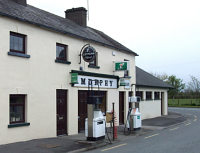
|
August 2012: Small Irish service stations
Small streetside filling stations have disappeared from most countries of Europe, but a small number remain in rural areas of the Irish Republic. This article looked at a number of examples, often associated with a village store or even a bar, as at Murphy's in Bracknagh, Co. Offaly.
|
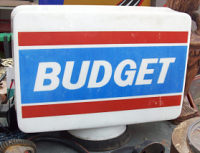
|
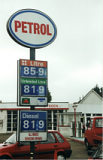
|
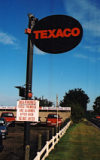
|
May 2012: Reused street signs
Old illuminated street signs are sometimes recycled by inserting a new company logo or a generic indication of selling petrol. Among examples from three continents were an Esso reused for unbranded Petrol and one that had been turned into Texaco, and a Mobil that had simply become Xang Dau (Vietnamese for petrol).
|
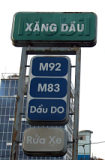
|
|
March 2012: More Fina from the Netherlands
After September's look at Sinfina, this article looked at some of the ways that Purfina then Fina attempted to distinguish themselves in the Dutch market. One way was through commissioning distinctive architecture on company-run stations, notably designs by Sybold van Ravesteyn as in the Purfina station in Groningen (right).
Image courtesy NAI (Nederlands Architectuurinstitut)
|
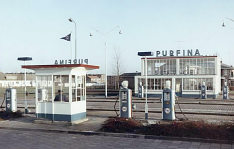
|
|
January 2012: Quiz -
Europeans in America

|
A second seasonal quiz was themed around Europeans in America, with ten cases of Europeans companies which had service station interests in the USA. Although some were well known, others such as Hunting Petroleum's ownership of the Fuel Boss cardlocks, or BP's entanglement with Gibbs in New England are less commonly heard about. One of the questions asked which European company acquired Apco, Leonard and Vickers, seen here from logos on US road maps? |
|
November 2011: Beaulieu Autojumble 2011
The September Beaulieu Autojumble had a record number of stalls, including more than 10% from overseas. This enabled much interesting petroliana to be shown including a large number of French 2 litre oil cans, such the examples shown from Antar. It was also a good year for unusual globes, with examples seen from Ascot, Conoco, Kent, Majors, Olympic and Pursan. And in the affiliated auction, a very early and hitherto unknown enamel sign was sold advertising Strange's A.1. Motor Spirit.
|
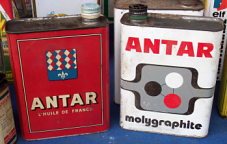
|
|
September 2011: Sinclair, Sinco and Sinfina
The US firm Sinclair was active in Europe in the 1920s and 30s, operating mainly in the Low Countries, but also selling oils across Scandinavia, Germany and central Europe. By the mid-1930s the Dutch market was falling under the domination of Shell, so Sinclair teamed up with Purfina in a joint venture that led to the introduction of the Sinfina name on service stations in the Netherlands. This article looks at the Sinclair and Sinfina operations prior to Sinclair's sale of most of its European assets to BP in 1938 or 9.
|
|
June/July 2011: Redline and Phil Easdown's Vintage Garage
Phil Easdown is a UK petroliana collector who operates the Vintage Garage website. This Letter from Europe interviewed Phil, finding out how he became involved in the hobby, and looked in particular at one brand from his collection - Redline, which was owned by the Union Petroleum Products Company, prior to being bought by Esso in the 1930s.
|
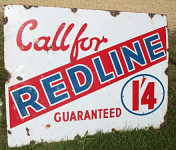
|

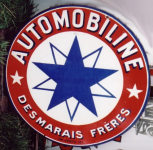
|
May 2011: Azur
The French company of Desmarais Frères used the name Automobiline, and introduced Azur as a premium grade in 1932. Azur became the primary branding in 1950, until the company was acquired by CFP-Total in the 1960s.
|
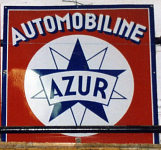
|
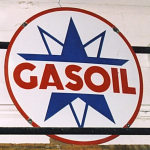
|
|
December 2010: A Christmas Quiz
This seasonal quiz showed signs and stations from a large number of US-controlled companies in Europe, ranging the 1930s to 1990s. Question 1 asked which companies controlled, respectively, Adler, Cleveland, Dominion, EP, Gainsborough, Redline, Tops and VIP - and in case you wish to know,
the answer is summarised at the foot of this page!
|
|
October/November 2010: Letter from Texas
For a change from Europe, this article was a Letter from Texas, Oklahoma, Kansas & Missouri. It included short reports from the Conoco and Phillips 66 museums in Oklahoma, as well as the East Texas Oil Museum. It also showed former service stations from brands such as MFA, Midwestern, DX and this Phillips 66 station in Baxter Springs preserved by the National Park Service, as well as a few operational stations including an early 1970s Shell shopping mall site and the recently built Pops station in Arcadia.
|
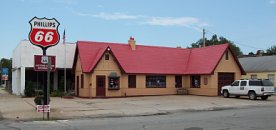
|
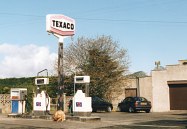
|
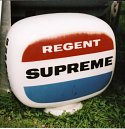
|
August/September and June 2010:
Texaco and Regent
A pair of letters looked at Regent and Texaco in Europe. These were illustrated by a number of photos of signs, pumps, globes, a tanker, maps and service stations from both companies.
|
|
April 2010: Retromobile, Paris, 2010
Retromobile is a major exhibition held annually in Paris devoted to all types of old road vehicles. In recent years it has grown to include a collectors market on the final weekend, at which the selection of handy oilers shown here was on sale.
|
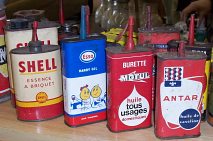
|
|
February 2010: Comparing US and European map designs
This article was on more familiar ground to this website, as it showed the relatively few instances where North American maps shared a common design with their European counterparts. The earliest known example of this was on a 1929 Texaco map of Kentucky & Tennessee which used the same cover design as similar era maps of Belgium.
|
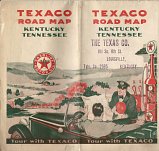
|
|
December 2009: Beaulieu Autojumble 2009
This report from the annual Autojumble included several enamel signs (including ones from Top, Blue Star, Brigsolene and Murco), globes (glass, plastic and repro) and oils cans. The cans ranged from 1970s one litre can (showing an Angenol as well as more common Shell, Esso, Castrol and Gulf) through French two litre cans (where a Vall-oil mimicked an Esso can) to pre-war 5 gallon cans from Germ Oils and Sternol.
|
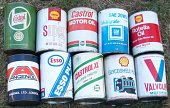
|
|
October 2009: BP's 100th Birthday
2009 was the centenary of BP (which had been established in 1909 as the Anglo-Persian Oil Company), although the BP name is slightly older, having first been used by an German-owned importer of Romanian fuels around 1906. To mark the event, this Letter from Europe gave a summary of the company's history and provided a broad overview of some of the collectibles that can be found carrying the BP branding, such as the early red enamel sign, dating from before the introduction of the famous green and yellow shield.
|

|
|
August 2009: Essex Service Stations - 1979 and 2009
In 1979, I took a number of photographs of smaller service stations in Eastern Essex. This article looked at some of these photos, and compared them with the businesses in operation at the same locations in 2009. Among the filling stations that have disappeared over the past 30 years was Crampin's Garage, a very small Ultramar dealer in Tiptree, that had been operating since the early 1930s.
|
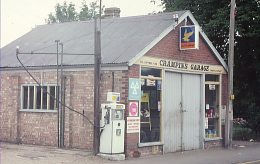
|
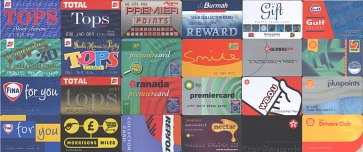
|
March/April 2009: Reward Cards
Most of the items of petroliana that are collected today would once have been regarded as worthless. This Letter looked at what may turn out to be a future collectible - the loyalty cards that have been used by petrol companies over the past twenty years or so for storing electronic points, and included examples from Total, Fina, BP, Morrisons, Jet, Gulf, Action/Telegraph, Shell, Repsol, Texaco and Burmah. |

|
Jan/Feb 2009: The CM Booth Motor Museum
The C.M. Booth Motor Museum (also known as the Morgan Motor Museum) is based in the village Rolvenden, Kent. As well as containing the largest private collection of Morgan motor cars, it includes a vast range of motoring ephemera, including many petrol and oil related items, such as the Cleveland pump and Pratts enamel sign in its furthest corner.
|
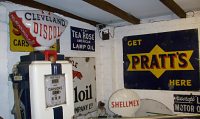
|
|
November 2008: Beaulieu Autojumble
The 2008 Beaulieu Autojumble was another superb event for finding all sorts of automobilia and petroliana. Among the extensive selection of petrol pump globes, one vendor had a VIP globe that had been stickered over with the name of the successor brand, Elf. The same vendor also had a National Benzole map rack for sale.
|
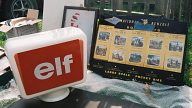
|
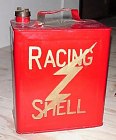
|
August 2008: Two Gallon Cans
Bas de Voogd is a leading Dutch collector of two gallon petrol cans (and their European equivalents). He contributed a guest "Letter from Europe" on the subject, including suggestions on how to start a collection and where they may be found.
Image courtesy Bas de Voogd
|
|
March and May 2008: Burmah and America
Two successive letters looked at the history of the Burmah Oil Company from its first move into European downstream operations in the 1960s to its eventual takeover by BP in 2000. They also looked at the attempts Burmah made - unsuccessfully - to enter the US retail market through proposed, but aborted, deals with Atlantic and Conoco, and speculated on whether these deals would have significantly changed the US and European petrol markets.
|
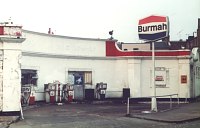
|
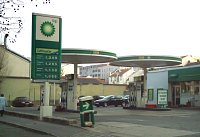
|
January 2008: Eliot Noyes designed service stations
The American architect and designer Eliot Noyes worked for the Mobil Oil Corporation between 1964 and 1973, creating a unique style based around circular canopies and cylindrical pumps. The basic design remained in use until 1987, and was applied internationally. Twenty years later, Noyes designed stations can still be seen in Europe, despite Mobil having sold its operations here to BP in 1999. Earlier disposals mean to other companies (and some independently supplied stations) mean that these distinctive features could occasionally be seen on brands as diverse as BP, Shell, Q8, Total and Aral. This article illustrated examples from all those companies as well as Mobil itself, using examples from service stations in the USA, UK, Belgium, Denmark, France, Greece, Italy and the Netherlands.
|
|
November 2007: Roadside Memories Museum
This letter features the museum established at Colyford, Devon, with its extensive collection of petroliana, including many petrol pumps rescued from small local filling stations. The museum is housed in a purpose built annex to the former garage in the village, which was originally built in the early 1930s and was frequented by T.E. Lawrence at one time.
|
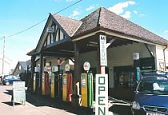
|
|
September 2007: Five Gallon Cans
Many British lubricants companies, especially those not affiliated to petrol suppliers, sold motor oils in five gallon cans that could be stored by motorists at home to provide oil when needed. The larger format also allowed the graphic artists a more expansive canvas on which to decorate the oil can.
The example shown here comes from Millers Pistoneeze from the 1960s; others shown in the article came from Bartoline, Coopers, Gamages, Liberty, Qualube, Silver Knight, Sternol, Thelson Oils, Vigzol and Vitafilm.
|
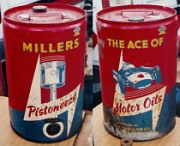
|
|
July 2007: The 2006 Beaulieu Autojumble
In advance of the 2007 Autojumble, this letter looked back at the previous year's event. Among the items shown were the two globes here, from the British independent brands Sadler (which was acquired by Q8) and Baxter Johnson (which is now owned by WCF), with its Monty Pythonesque sign.
|
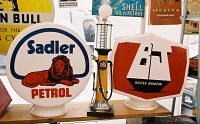
|
|
March 2007: Rob Griffin's Badge Collection
Rob Griffin is a Welsh collector of enamel badges, from all industries (not just petrol or oil related). Some of his most interesting and graphic oil company items were featured, including the National Benzole and Mobiloil badges shown here.
|

|

January 2007: The tenth birthday of Letter from Europe
This article celebrated over 10 years and 50 editions, by updating some of the earlier stories. Among other items, it featured a 1934 service station in Newbury (the Electric Service Station) with an unusual green pantile roof that the twentieth century society wish to preserve. It also added Veloxol and Vitamol to the list of V..L lubricant brands.
|
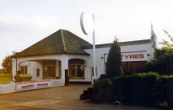
|
September 2006: Alcohol Blends
 |
Taking its cue from a 1930s photograph of a Cedar Rapids, Nebraska gas station on the September page of the Check The Oil! calendar, this article looked at some of the suppliers of alcohol-petrol blends in Europe, including Agrola from Switzerland and Cleveland Discol from the UK.
|
July 2006: Shell's 1930s German Maps
The topic covered by this article needs no introduction to users of this website, as it focused on maps from pre-war Germany.
|
May 2006: V..L brands
This Letter from Europe was written as the 45th, and offered a chance to look at V..L brands of petrol and oil in Europe: Veedol, Viscobil, Varol, Vigzol, Vanwil, VOL, Viwobil, Vaxol and two not ending in "L" - Valvoline and Vostaline. VOL Service station in Beek en Donk, Netherlands, 2000
|
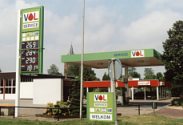
|
January 2006: Beaulieu Autojumble
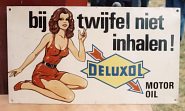 |
The annual review of the Autumn Autojumble included a number of signs - a valuable BP the Winner from the 1920s, an early Castrol Fill Your Sump from the Castrol pump and this Dutch No Smoking warning from Sunoco look-alike Deluxol. It also featured two-stroke pumps and a selection of plastic globes from the UK.
|
July 2005: Brussels Retro Festival and the Museo Fisogni
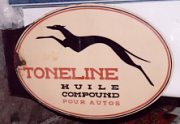 |
This Letter looked at two quite separate things: the October 2004 Brussels Retro Festival and the Museo Fisogni in Northern Italy. The annual Retro Festival has a limited amount of petroliana for sale and in 2004 it included a fine Toneline flange sign. In contrast, the Museo Fisogni is Europe's largest collection of petroliana, but it too is for sale...
|
|
March 2005: Beaulieu Autojumble
March's Letter from Europe looked back to the Autumn Autojumble at Beaulieu. Among the items on offer were enamel signs for Royal Elephant paraffin and BP "Banish Pinking", as well as globes from NFO, EP and Avia. But one of the more interesting items was an early 1960s colouring book given away by Esso dealers called Uncle Bill's Surprise. Inside children were able to colour quite detailed scenes including Esso stations for both cars and boats.
|
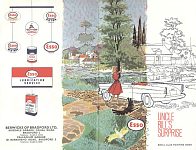 |
 January 2005: Alan Vale's Collection
January 2005: Alan Vale's Collection
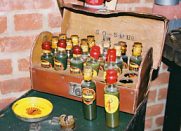 |
Alan Vale is a Surrey collector of vintage cars who, around five years ago, decided to add some petroliana to help display his collection. Since then he has become a major collector and restorer of petrol pumps, as well as having a number of high quality smaller items, including a pre-war Shell samples kit designed to show garage owners the range of Shell oils and greases available.
A book about his collection can be ordered from www.petroliana.co.uk
|
September 2004: Total - the International Gasoline
|
The French company Total, which used the slogan "the International Gasoline" on its now sold-US operations, has through its recent acquisitions of Fina and Elf become one of the top 4 oil companies in the world. This article, coinciding with the 50th anniversary of the introduction of the brand, traces its history and includes a rare image of a TOTAL-GB filling station, resulting from a short lived joint venture with Tenneco in the Netherlands.
|
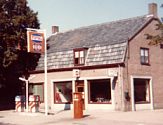 |
|
July 2004: Dominion News
Dominion started supplying petrol to English filling stations in the 1920s and was soon acquired by the US company Marland Oil. In 1934 Dominion Motor Spirit was sold to Shell-Mex & BP Ltd, but the name continued to be used as a discount brand at free stations. To help give a quality image, it gave away a monthly magazine, Dominion News, and this Letter looks at some of the illustrations and other content from the publication.
|

|
March 2004: Toy Rail Tankers
|
Earlier Letters from Europe have looked at toy road tankers, so this one turned instead to rail tankers, mainly made for the UK, French and German markets, by firms such as Hornby, Bachmann, Lima, Jouef and Märklin. One attraction is that they often model names found only rarely on maps, such as Burmah, Campsa or Elan, as well as early companies such as GLICO, Carburine and Trent Oil Products (Top). This OO gauge Airfix kit of an Esso tanker was also featured.
|
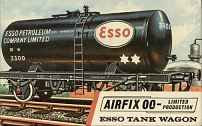
|
January 2004: The 2003 Beaulieu Autojumble
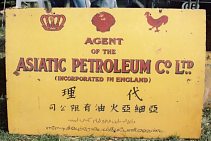 |
The 2003 Beaulieu Autojumble was blessed with hot sunny weather - so hot that some vendors thought buyers were reluctant to buy! Among the goods on offer was this pre-war enamel sign from Shell's Asiatic Petroleum Co with inscriptions in English, Chinese, Tamil and Malay.
|
November 2003: Brussels
|
Brussels has several different features for those interested in service station history, including displays of enamel signs from Elektrion Motor Oil and other companies in the Autoworld museum. It also still has service stations built underneath apartment blocks - and the Atomium, as featured on 1958 Esso maps.
|

|
September 2003: Spidoléine

|
Spido enamel signs, originally mounted on walls, are occasionally found (left). Spidoléine was the brand name used by S.A. A. André Fils of Paris, a lubricant company established in 1877. Like many such companies, it occasionally issued a "Guide Spido", with hints on choosing the right oil. The 1929 Guide was, typically for its age, augmented with stylish adverts for Spidoléine (right).
|
 |
July 2003: Techno Classica Essen (and Service Station design according to Minale)
 |
April saw the 15th Techno Classica Essen show, which is probably Europe's largest classic car show. Among the petroliana on display was a finely restored Esso Zapfstelle pump, dating from the 1930s. The same edition also included a report from Earl Ma on work done by the late Marcello Minale, including his designs for Lukoil service stations (seen right in Bucharest).
|
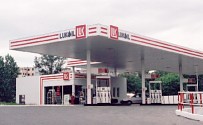
|
March 2003: French Standard Service Stations from the 1930s
 |
This Letter from Europe looked at some photographs of Standard (Esso) service stations in France, shown in a book of Esso Itineraries, first published in 1934. Several distinct architectural influences were noted, including the US originated design shown left at Creteil, near Paris.
|
 January 2003: The 2002 Beaulieu Autojumble
January 2003: The 2002 Beaulieu Autojumble
|
This was the second report on the petroliana available at the National Motor Museum's autumn autojumble and commented that it was a good year for globes, but less so for pumps. One of the more unusual globes came from John Hudson, an East Anglian independent that later joined Avia, but which had been converted into a Total by adding a self-adhesive decal.
|
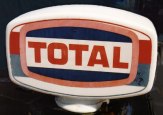 |
November 2002: Petrol Tankers
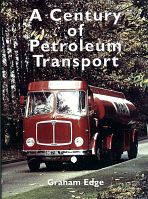 |
There are possibly more people in the UK interested in road tankers than maps or general petroliana, so this letter reviewed a couple of fairly recent books devoted to the subject. Graham Edge's A Century of Petroleum Transport was highly recommended, although Hinton Sheryn's Illustrated History of Road Tankers also has points in its favour. The article started with the memory of a sighting of a Sotro tanker in 1967; it ended by showing a Sotro station overgrown with trees 25 years later.
|
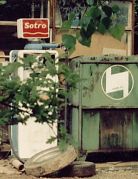 |
September 2002: Memoires en Route - an exhibition in Paris
|
In May 2002, a group of French collectors arranged a small display of automobile and map related collections at the Autodrome of Linas/Montlhéry, just South of Paris. Among the collections on display were enamel signs owned by Luc Beunoit, including this fine example from Raffineries de Pechelbronn, showing its Antar, Socaline and PEN logos. Socaline (=Société Alsacienne des Pétroles) is not known to have issued maps, except through its joint venture in Switzerland with Petrofina, Socal Fina. Luc maintains an excellent web site displaying part of his collection: www.pubemail.com
|
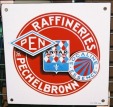 |
May and July 2002: Trading Stamps in Europe

|
These two articles looked at trading stamps in Europe. May's started with those generally issued including Green Shield Stamps, S&H Pink Stamps (used as Sperry & Hutchinson could not use green), the Co-op, Blue Chip and the short-lived UK operation of King Korn (left). July's looked at Belgian names such as Valois and Melior, and those linked to service stations such as Look, or issued by petrol brands including Jet, Esso, Seca, Butler and Antol (right).
|

|
March 2002: Theo multiple pumps
In the 1930s, the Liverpool-based firm of Theo & Company Ltd sold "multiple pumps" where a single fuel dispenser could sell up to six brands of fuel. These allowed UK service stations to offer all the popular grades without cluttering their forecourts.
 January 2002: Alternative sources of petroliana in the UK
January 2002: Alternative sources of petroliana in the UK
|
Petroliana can be quite hard to find in the UK. As well as the popular Beaulieu Autojumble, there are other events where it may be found, including the Great Dorset Steam Fair held every September, where the Vacuum Oil Company sign shown here was on sale.
|
 |
November 2001: The origins of Elf
With the recent mergers to create TotalFinaElf, this letter took a timely look at its history, including some of the smaller names associated with it such as Elan, La Mure and NerVol.
September 2001: Romania
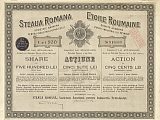 |
Romania claims to have the world's oldest oil industry, dating back to 1857. By the start of the Second World War it had many refineries and independent companies such as Steaua Romana, which issued the share certificate shown here in 1923. After the war it developed along national lines until the mid 1990s. This letter looks at some of the few surviving items from the pre-war industry, as well as describing the Petroleum industry museum in Ploiesti.
|
July 2001: Susanne and Peter Bonito's Austrian Collection
Susanne and Peter Bonito live in Vienna and have an extensive collection of petroliana, featuring Mobil and Shell. This letter looks at how Susanne started their collection and focuses on some of their favourite items. They also maintain an excellent website.
May 2001: Rétromobile
 |
Rétromobile takes place each February in Paris. The 2001 exhibition had a good selection of petroliana on sale, including cans, globes, pumps and metal signs, such as this 1930s example from Texaco, promoting Babytex lubricants sold in a half-litre container.
|
|
March 2001: More small collectibles
Carrying on the theme of the October Letter, this article looked at more small collectibles issued by petrol and oil companies, including key rings, such as those shown from Cepsa and Heron. Also featured were badges and some licence plates issued as a promotional item by Deutsche BP.
|
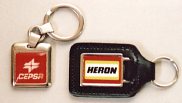 |
 December 2000: The Beaulieu Autojumble
December 2000: The Beaulieu Autojumble
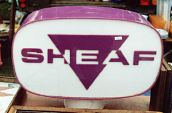 |
Each September, the National Motor Museum in Beaulieu, Hants. hosts Britain's largest autojumble. Many stalls have a selection of petroliana, and this report looked at some of the globes, signs and pumps on sale. One of the more unusual items was an early 1970s globe from Sheaf, made from three sheets of plastic and carrying Sheaf's distinctive purple and white colours.
|
October 2000: Oil Company Pins
|
Small lapel pins are amongst the most widely collected items of petroliana in Europe. This article shows 14 pins, mainly from the 1960s, used by service station attendants or tanker drivers, plus a further 13 more recent promotional pins from France.
|
 |
|
August 2000: Five old pumps...
A look at five old petrol pumps from Britain, each with a tale to tell. One of the five was an abandoned BP pump in Withington, Gloucs. (right).
April 2000: Conoco in Europe
A brief history of Conoco in Europe, starting with its 1960s acquisitions of Jet, SOPI and Seca. The article also looked at been more recent operations in Scandinavia where Conoco acquired the Maxi and ARA chains, and at the much earlier involvement of Conoco's predecessor company, Marland, when it set up the Sealand Petroleum company in London in 1926.
|

|
|
February 2000: Petrol companies as publishers
European petrol companies have often published books, partly as a means of encouraging motorists to get out and see the countryside. This article looked at several examples from Britain, published by companies such as Shell, BP, National, Jet and Total. It also refers to some published in continental Europe.
|
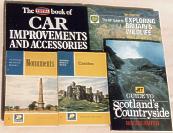
|

|
December 1999: Tunisia in the 1930s
This month the letter crossed the Mediterranean to Tunisia and looked up at the oil companies operating in there in the 1930s. There are copies of some classic adverts which were published in la Tunisie Automobile, the magazine of the A.C.T. Companies represented include Shell, Esso, Mobiloil, and Kervoline. A classic early 1960s Total station is also shown.
|
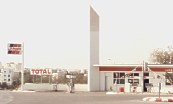
|
|
October 1999: The history of Fina
Noting that Fina had just been acquired by TOTAL, this month's letter looked at the history of Fina from its origins in Belgium in the early 1920s. Starting with the production of oil in Romania and Chechnya, Fina soon developed a downstream activities in Belgium, France and Britain, where it acquired Citex.
|
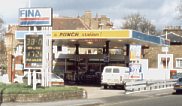
|
The article shows Fina stations operating under a number of different signs, as well as the Socal Fina variants used in Switzerland. There is also mention of Fina collectables including the once ubiquitous inflatable toys and cars given away by British service stations.
August 1999: The London Classic Motor show and Britain's last globe?
|
The London Classic Motor show is held in late March each year at Alexandra Palace in North London. The 1999 show included some interesting small Petroliana, and featured an interesting display of cans and other small items from Mike Berry. The article also looked at a recently discovered design of Butler globe that appears to have been introduced as late as 1996.
|
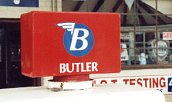
|
 April 1999: Speedwell Oils
April 1999: Speedwell Oils
Speedwell Oils were marketed by the British Oil and Turpentine Corporation under the slogan "running made easy" and showed a tiger chasing a native boy with a can of Speedwell Oil on his head. A 1935 booklet promoting the oil ran to 136 pages of hints, tips and delightful advertisements. The letter also looked briefly at the oil can collection of a Cambridgeshire collector.
February 1999: Ray Walls' globe collection
Ray Walls has several hundred globes in his collection ranging from early examples by Shell, Bluebird and Pratt's to relatively modern plastic globes from companies such as Ultramar, Baxter Johnson, Sadler and Burmah.
December 1998: Ray Walls' Petroliana collection
Raymond Walls lives just outside Belfast in Northern Ireland. He has what is probably the largest collection for Petroliana in UK with several thousand items: mainly from Britain and Ireland, but with a few from France, Holland and the USA. Highlights include large numbers of lubricating oil cans, two gallon petrol cans and enamelled signs dating back from the 1920s.
|
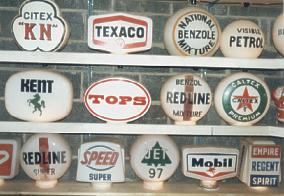
|
October 1998: The Russians in Europe
Russian oil companies have time to time become involved in the Western European petrol markets. One of the first of these was ROP which sold cut price petrol in Britain in the 1920s and 30s under the ZIP brand. Another Russian operation used the Nafta brand in Sweden in the 1930s and this name was revived in the 1960s for use in Britain and Belgium. Nafta's British operation was sold to Q8, which had bought Gulf in the rest of Europe, and the letter also shows a rare UK Gulf globe still in use at a small Devon garage.
June 1998: Retromobile
Retromobile is the largest annual event devoted to Automobile and boat related materials in France. The February 1998 show had some excellent enamelled signs, cans and globes on display.
|
April 1998: Children's toy tankers and garages
A look at children's toys produced by companies including Matchbox, Dinky, Hot Wheels (formerly Corgi) and Majorette. Two Indian models, based on early Dinky designs, were also featured in the colours of Bharat Petroleum and Indian Oil.
|
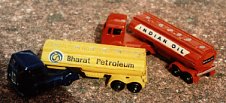
|
February 1998: The role of Petroleum Co-operatives in Europe
This letter featured the history of the OK co-operative based in Sweden. It also looked briefly at some of the agricultural co-operatives in the UK with retail fuel operations.

|
October 1997: Petroliana in Sweden
To coincide with the opening of a large exhibition at the Nordiska Museet in Stockholm called "Bilen" (cars), the article looked at some of the Petroliana to be found in Sweden. Items were also featured from the Motor Museum in Motala, and there was an image of maps from a number of companies.
|
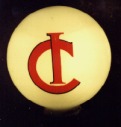
|
|
August 1997: Giveaways from British service stations
There was a brief look some of the football related giveaways from British service stations as well as a small garage in Cheltenham that had been operating more or less continuously since 1912 under one family ownership.
|

|
June 1997: Two British Museums
This letter looked at the collections of Petroliana that can be found in the Cotswold Motor Museum in Bourton-on-the-Water and in the Lakeland Motor Museum at Holker Hall in Cumbria.
April 1997: Europe's secret service stations
Three American companies had small service station operations in Europe that were not publicised by in the USA. They were Kendall and Getty which both operated in Italy in the 1960s, and Phillips 66 which supplied the small chain in Britain under the TOPS brand.
February 1997: German Zapftstellen
In the 1930s when space in German cities was at a premium, many oil companies developed so-called Zapftstellen that were basically small sidewalk buildings that both stored and dispensed petrol. The letter shows examples from Olex, Leuna and BV.
December 1996: Finds in East Anglia
East Anglia is a predominantly rural area of England where there are still a reasonable number of smaller service stations. This letter showed a pair of Phoenix pumps plus an abandoned station on the A143 and described some of the other smaller names to be found in the area.
|
October 1996: BP and Mobil collectables
As BP and Mobil were about to merge their downstream operations in Europe, this letter looked at some of the collectables to be found from the two companies, including a rare modern design of Mobil globe.
|

|
August 1996: the first letter from Europe
The first letter from Europe gave an introduction to the collecting hobby in Europe and showed advertising signs from BP and Dominion Motor Spirit.
The Christmas 2010 quiz answers are:
Adler - Amoco, later sold to France's Elf
Cleveland - Esso
Dominion - Marland, but sold to Shellmex-BP soon after Marland's merger with Conoco
EP - Murphy Oil (Murco)
Gainsborough - Sinclair then Atlantic Richfield (Arco), later sold to Total
Redline - Although it claimed to be 100% British-owned, Redline may have had links to Union Oil Company of California, but was later sold to Esso
Tops - Phillips 66
VIP - Signal Oil, then Occidental (OXY), later sold to Elf

Text, layout & images © Ian Byrne, 2000-16
All original copyrights in logos and map extracts and images are acknowledged and images are included on this site for identification purposes only.
 Check The Oil! - Letters From Europe
Check The Oil! - Letters From Europe



















































































